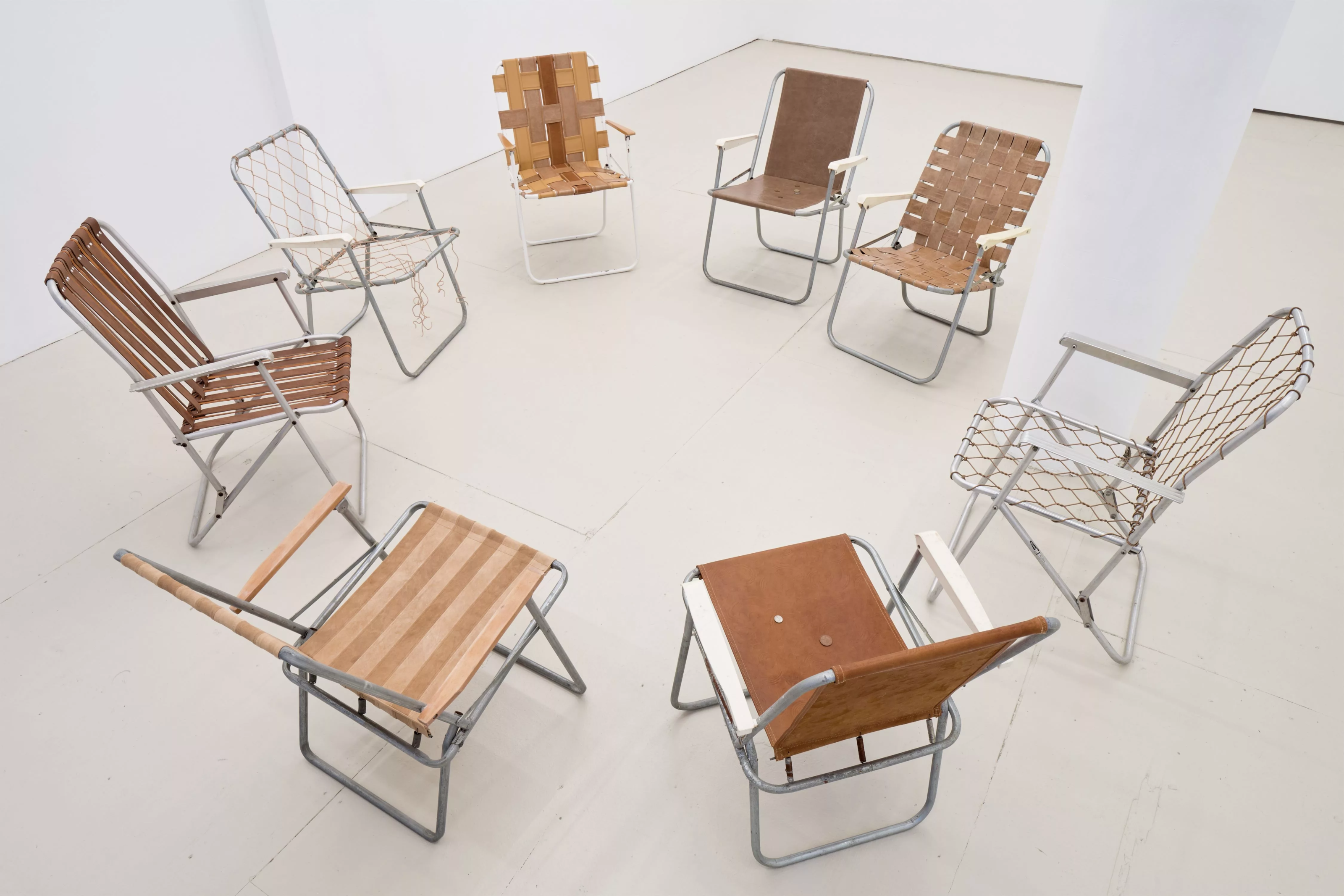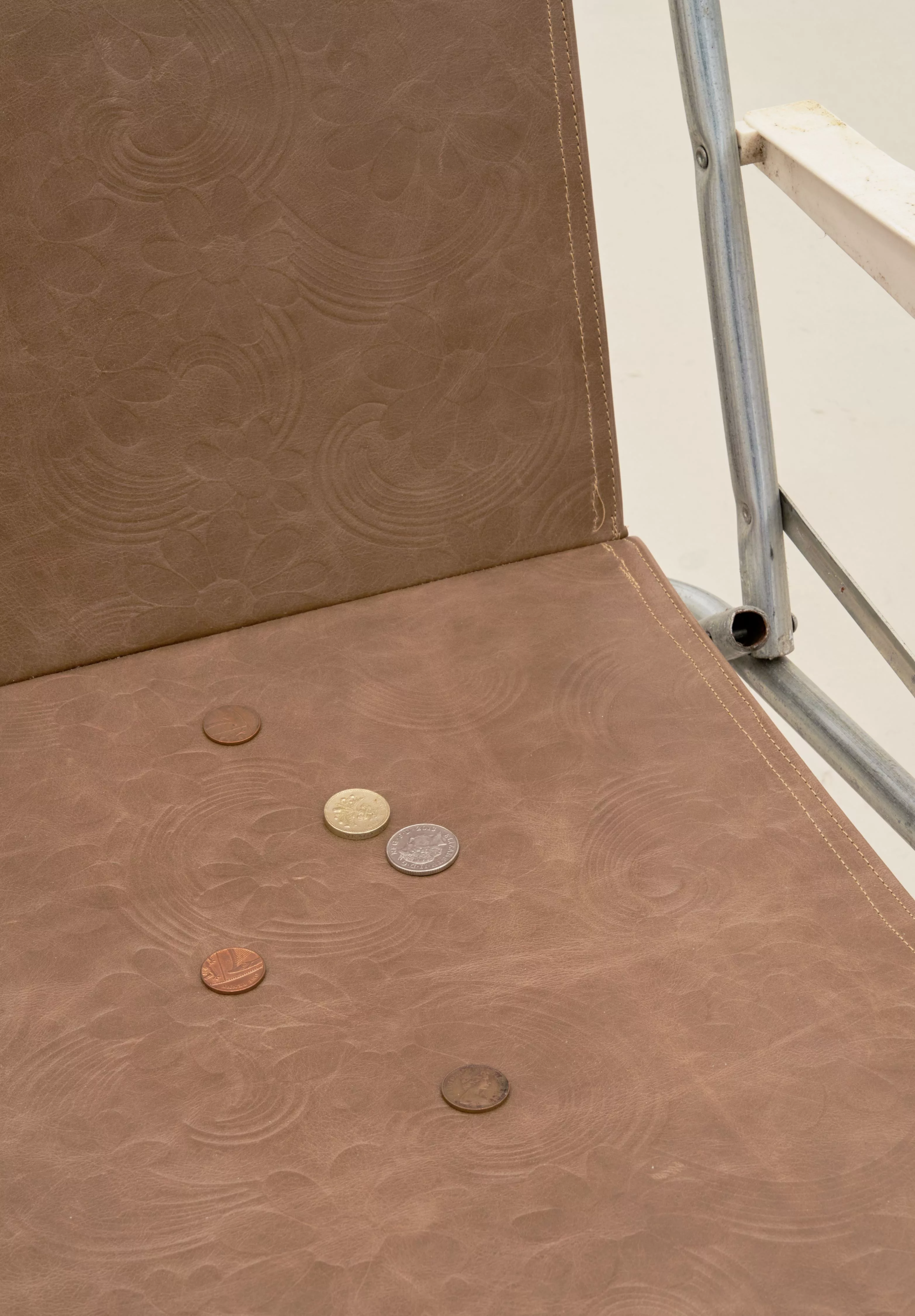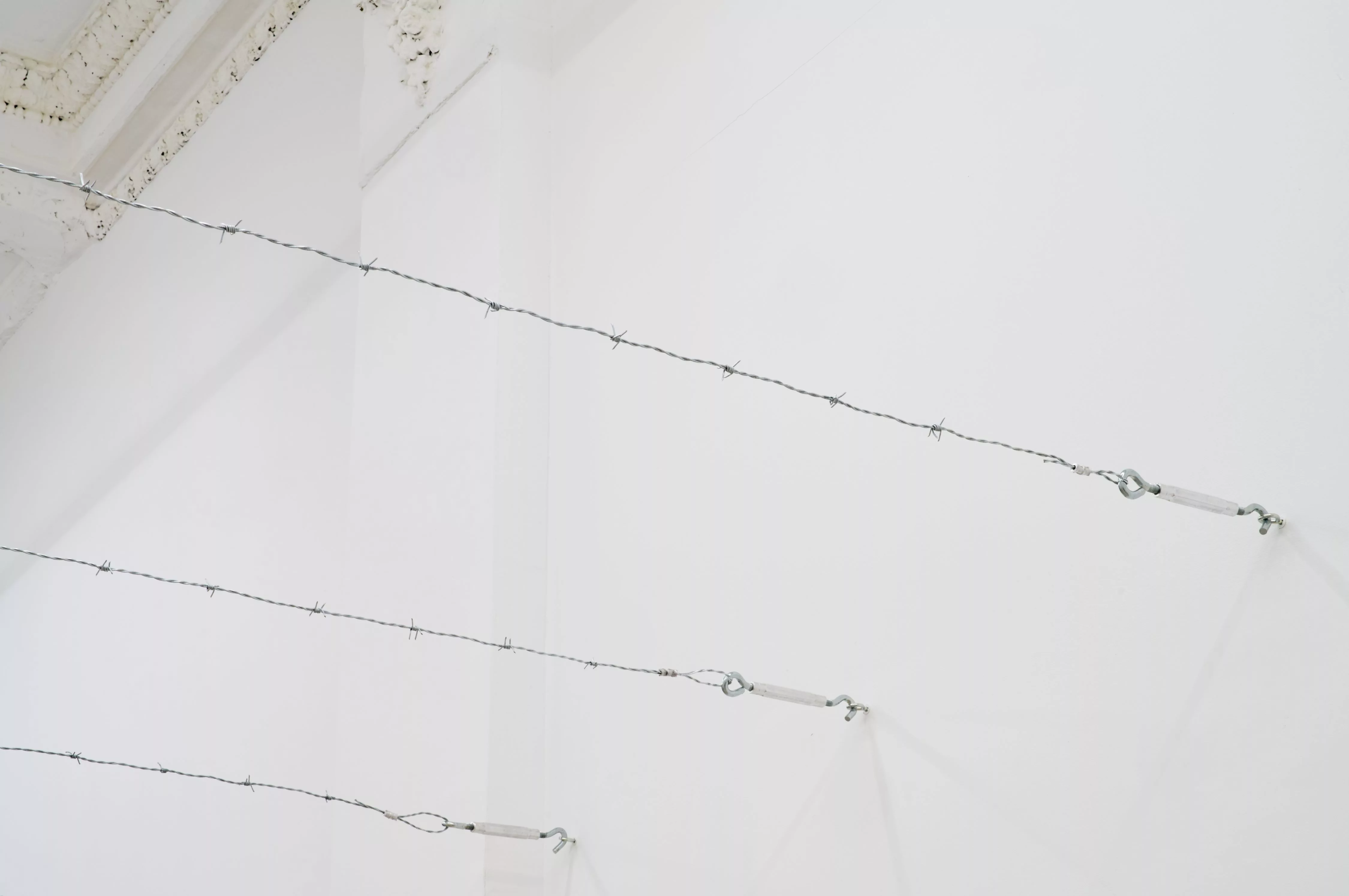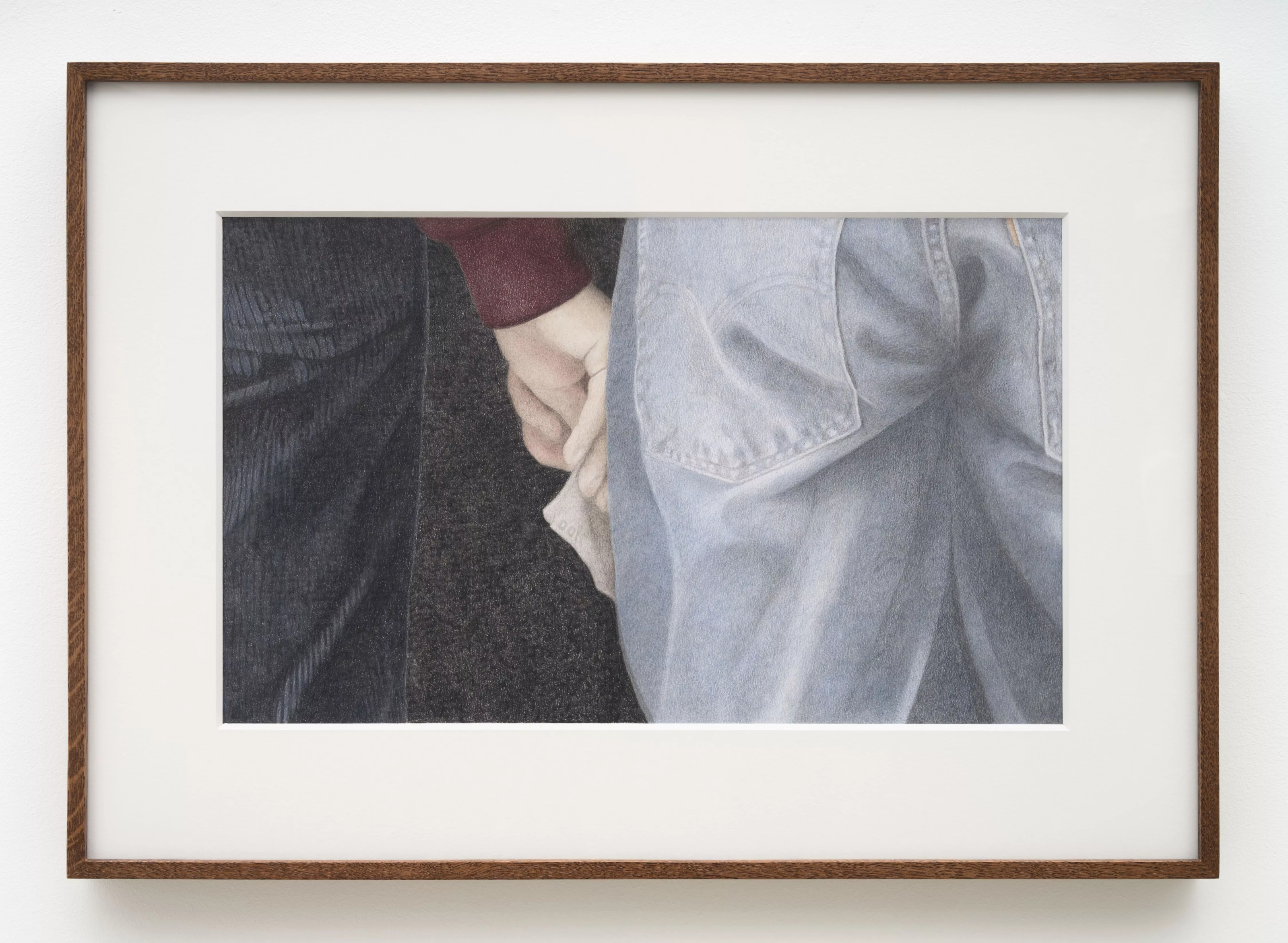
The London-based artist Eva Gold (b. 1994, Manchester, UK) uses a methodology of fragmented storytelling in her work. Her first exhibition in New York, titled Shadow Lands, on view until April 20 at Silke Lindner in Tribeca, draws from her study of cinema, and situates various different media in dialogue with each other. Gold’s practice spans sculpture, installation, moving image, writing and drawing. She completed her BA at Goldsmiths in 2016 and her postgraduate at the Royal Academy of Art in 2019, and has had previous at Rose Easton and Sadie Coles in London in 2023 and Eigen+Art Lab in Berlin in 2022. In this interview, Gold tells Elephant about the beginnings of her development of her practice and the thinking behind her work.
When did you know you would pursue a career as an artist?
I think from quite an early age I knew I wanted to do something creative. I used to spend a lot of time making things when I was a kid, just as a form of play really. When I was around thirteen, I wanted to do costume and set design, which is quite funny because that impulse is still there in some of the work I make now. I didn’t really know you could be an artist as a job because nobody tells you that in school. In fact, I remember most of my teachers actively trying to discourage me from studying art, because it was seen as a subject with very little academic value. But I think that just motivated me to want to do it even more.
You have worked across a wide range of mediums, including sculpture, installation, drawing and moving images. How did your exploration of mediums develop over time?
I started working with sculpture during my foundation, but even then, I was engaging quite directly with the context and space in which I was working, so it was already expanding out. I would say that most of what I do is installation, because in the process of exhibition-making I’m always thinking in terms of the relationships between the works and with the space. This extends to writing, moving images and even when I’m showing drawings, which is the newest medium for me, I would consider them to be under the umbrella of installation.

What were your focuses in university?
I studied on the Fine Art + History of Art programme while I was at Goldsmiths, which I remember being really very demanding—more like doing two degrees side by side.
The History of Art side was in the Visual Cultures department, and the most standout thing was that I got to work with Mark Fisher for the final two years. He had a way of making sense of the world, of understanding cultural events within a social and political framework, coupled with this very astute sensitivity, that made him a very inspiring tutor. At the time I was mostly writing about film, and in particular studying the American landscape and its presentation in cinema: trying to trace a feeling of bleak detachment or a quality of disaffection in the desert landscape and the city, and the highways and gas stations in between.
In the Fine Art part of the course I was really focused on making. They have really incredible workshops and technical staff so I dove in pretty deep there. I remember having this realisation that it would be possible to make pretty much anything I wanted and that was quite amazing. I was working in quite a different way then—really striving to get this perfect level of finish, something so slick and clean that you almost couldn’t tell it was made by a person. Reflecting on it now, I was definitely trying to prove something to myself about what was possible. That’s something I began to back away from a lot while I was at the Royal Academy, I became interested in a more abject material quality, something dirtier.
When I was at the RA my interest in film started to surface in my studio practice in a way that hadn’t really occurred to me earlier. I was still working predominantly with sculpture, but I also started experimenting with lighting at that time, and also writing too. Everything I was making was getting a lot rougher at the edges, and darker.

You were a resident at Rupert. What did you produce there?
I was working on a long-term writing project—a text, or a series of texts which deal with the subject of consent and agency, and the grey areas in which the definitions begin to collapse. As part of this I was looking at the ways in which practices of care and coercion can be intertwined; and trying to understand the concept of passivity and where that behaviour is learnt. More specifically, the subject of memory: the ways that it is continually shifting, and what implications this may have when forming discreet definitions of truth and fiction. It’s quite a difficult subject to approach, and I find the process of writing requires a kind of intense focus that I can very rarely get in London, so for the time being it’s very much still a work in progress.
What were some foundational artistic and literary references for you? And what are some of your current references?
I saw a Paul Pfieffer retrospective at MOCA when I was in Los Angeles recently, and that was one of the best shows I’ve seen in a long time. There’s some kind of magic to what he does that I find completely transfixing. Donna Dennis at O’Flaherty’s, New York—that was very memorable, very uncanny. I am also still thinking about the Lutz Bacher at Raven Row from a few months back.

In terms of foundational references, it’s hard to know where to start. I read America by Baudrillard when I was writing my undergrad dissertation, and that was pretty formative. Recently I keep coming back to Ordinary Affects by Kathleen Stewart, which is quite similar in some ways. They’re both portraits of America, but if Baudrillard is macro, surveying on a vast scale, then Stewart is micro in the way that she zooms into these really intimate exchanges. Ordinary Affects is a series of vignettes, just these glimpses of everyday scenarios, but there’s a kind of violent undertone or surface tension that runs throughout, always threatening to break. Contextually it’s very different to Baudrillard because it was written post-9/11, but also the observations are maybe more nuanced because it doesn’t have the detachment of a European gaze.
Shadow Lands at Silke Lindner is your first solo US exhibition, consisting of drawings, a circular formation of chairs, and an installation. Could you please talk through the thinking behind the show?
The show is a continuation of my ongoing interest in power, and the body of work comes resolutely from an experience of being in the world today. What I was trying to do was navigate a whole host of feelings that felt very pressing: distrust, or the destabilising of truth; precarity; isolation; disenfranchisement. I was thinking about these in relation to the current social, political and economic environment, and specifically systems or structures that are predicated on a concept of hierarchy.
The book I mentioned earlier, Ordinary Affects, was very much in my mind when I was making the show. Her methodology was something like the way I tried to approach the subject matter for the exhibition—stepping between the intimate and the vast, tuning my attention to the affective dimensions of the everyday, and the lingering resonance of passing events, rather than directly addressing the overarching system.
The process of making the show was about trying to articulate something, of trying to formulate a sort of logic or map of connections out of very fragmented parts. It was almost like trying to zoom in and understand, while simultaneously trying to step back and see the bigger picture.

Could you please talk about Michael Haneke’s Benny’s Video and how that plays into the drawings? And what is the meaning behind the title, Pilot and Passengers?
Pilot and Passengers is a pyramid scheme, also known as the Airplane Game, where players pay to join, recruiting new passengers in order to move through the ranks and increase their investments. It started in the 1980s, and it’s recently resurfaced on social media platforms, under various new names. In the film Benny recruits his friends to be part of the game, and during one scene they pass notes and cash back and forth while singing as part of a school choir.
When I watched the film, I felt that if removed from context, this scene had a resonance that echoed beyond the narrative of the film, and that could function as an abstracted standalone gesture. The drawings reproduce the spatial quality of this sequence—a low, slow, tracking shot, following this transaction in which many hands are implicated. There are many reasons that I’m interested in this film, but one key point is that the film has an interesting portrayal of the violence of social class. We see the notion of impunity play out, as Benny’s parents cover up his actions in order to protect their own social status.
Likewise Echo Chamber and Insider/Outsider—what is the viewer seeing in these works? What ideas did you want to evoke?
Insider/Outsider is a sculptural installation consisting of lengths of barbed wire tensioned across the width of the space. The gallery space has a really high ceiling, and I wanted to work with that in some way, especially since the rest of the works are all hung very low. It runs across the whole length, and brings the ceiling down by roughly one third, which I felt created an uneasy feeling of downward pressure. As an inherently violent material—generally used as a control mechanism for delineating who is permitted to be in certain spaces—there was a clear link for me to the concept of hierarchical power structures.
Echo Chamber is a circle of folding chairs, which I stripped back and reupholstered with different brown leathers—nappa, lambskin, cow hide. The idea was to have a second concentric circle positioned within the drawings, back to back, with one facing out and one facing in. The title speaks to these spaces online and IRL that in being closed, facilitate the production of an increasingly closed or polarising discourse. When thinking about a state of disenfranchisement, the image of a closed circle seemed to make a lot of sense, at both the top and bottom end of the register. In particular, my interest was in trying to understand why these spaces are appealing—what kind of weight is there to this kind of affirmative discourse? I saw the circle as a kind of stand in for an image of community and support, and when I’m thinking about how the disaffected or disenfranchised can be weaponized, I guess I’m thinking about how this state of being produces a desire or need for shared experience or ideology.
I would argue that we are all building walls around ourselves to a greater or lesser extent, in terms of the spaces that we hold, our belief systems, the communities we are part of, and for the most part this is just a protective strategy or an adaptive response to the incredibly complex environments that we live in. But the circle formation itself engenders very specific behaviours among groups of people, and that can be both empowering and incredibly destructive at the same time.

Is it accurate to say that some of the works in the show were featured at Rose Easton in City of Rooms? And could we please talk about that exhibition as well? You paired your work with a piece by Louise Bourgeois. Why did you select this work?
Yes, one of the chairs from Echo Chamber, appeared as a solo character in City of Rooms Part 1, where it was titled Soft Touch. This two part show was dealing with themes around surveillance and power, in relation to domestic and urban spaces. The title and premise of the show was a development of an idea I had been thinking about for a while, which was about this imagined network or labyrinth of subterranean rooms, interconnected across different cities and moments in time. The Last Cowboys at Ginny on Frederick was part of this, as was the drawing The Playground which I showed in a group exhibition around the same time, both of which made reference to nightlife in 1970’s New York, as well as contemporary Berlin. In the end, the context of City of Rooms was a lot less temporally specific, and made reference to a more liminal idea of space, coupled with a sort of ambiguous domesticity. But this idea of cell-like rooms situated within an urban landscape was my starting point, and I envisaged the two part exhibition structure as a kind of feedback loop, with an ominous sense of being under scrutiny, a suspended or mediated panopticon in which the public and private self gets blurred.
The Louise Bourgeois work came into it because for me this work straddled this feeling of being both on the outside looking in, and on the inside looking out. There are many different facets of her work that I love, but in this context, I was drawn by the way that she explores this sense of a private interiority. There is also a history of cells that she comes back to, and although The Curved House isn’t actually one of these works, I couldn’t help but read it along similar lines. The sculpture itself is carved from a very light pink marble and is a reproduction of the house that she and her family sheltered in during WWII. From the front it has this quite impenetrable quality, closed off and private and protected, but then as you go around it you see this ambiguous fleshy opening on the back. This sculpture just really resonated with me because of these different registers, or stages to reading the work, which I think gives the suggestion that something else unknowable is happening under the surface.
What else do you have coming up this year? What are you currently working on?
In the studio I’m currently working on a new series of light sculptures, some of which will be shown in Brussels and New York in the next few months. I have some works on show at the moment in a group exhibition Channel at Centre D’art Contemporain de Nîmes, as part of the Triennial. And then later in the year I will be part of a group show at CAPC musée d’art contemporain, Bordeaux.
Written by Gabriela Angeleti





